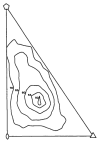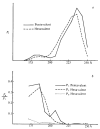Polyoma virus capsid structure at 22.5 A resolution
- PMID: 6276752
- PMCID: PMC4144041
- DOI: 10.1038/295110a0
Polyoma virus capsid structure at 22.5 A resolution
Abstract
X-ray diffraction data from polyoma capsid crystals were phased by refinement of low-resolution starting models to obtain a self-consistent structural solution. The unexpected result that the hexavalent morphological unit is a pentamer shows that specificity of bonding is not conserved among the protein subunits in the icosahedrally symmetric capsid.
Figures







References
-
- Adolph KW, et al. Science. 1979;203:1117–1119. - PubMed
-
- Klug A. J. molec. Biol. 1965;11:424–431. - PubMed
-
- Finch JT. Gen. Virol. 1974;24:359–364. - PubMed
-
- Caspar DLD, Klug A. Cold Spring Harb. Symp. quant. Biol. 1962;27:1–24. - PubMed
-
- Harrison SC, Olson AJ, Schutt CE, Winkler FK, Bricogne G. Nature. 1978;276:368–373. - PubMed

